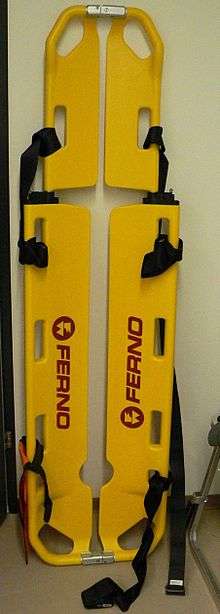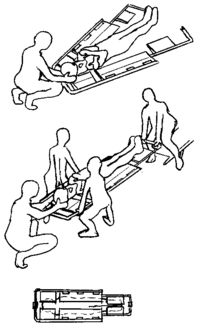Scoop stretcher

The scoop stretcher (or clamshell, Roberson orthopedic stretcher, or just scoop) is a device used specifically for moving injured people. It is most frequently used to lift people who may have a spinal cord injury from the ground, either due to unconsciousness or in order to maintain stability in the case of trauma.
A scoop stretcher has a structure that can be split vertically into two parts, with shaped 'blades' towards the centre which can be brought together underneath a patient. The two halves are placed separately either side of the patient, and then brought together until securing clips at the top and bottom both engage.[1]

Scoop stretchers reduce the chance of undesirable movement of injured areas during transfer of a trauma patient, as they maintain the patient in a supine alignment during transfer to a stretcher, vacuum mattress or long spine board). They are more comfortable than a long spine board for transport.[2]
The scoop stretcher can be used for patient transport, provided the patient is strapped. However, the ninth edition of the ATLS Student Course Manual advises against using scoop stretchers for patient transport.[3] For comfort and safety reasons, it is recommended to transfer the patient to a vacuum mattress instead, in which case the scoop stretcher is put on the transport device and then opened.[4]
References
- ↑ "Scoop Stretcher Application" (PDF). Prehospital Spinal Care. Emergency Technologies. Retrieved 25 May 2011.
- ↑ Ahn, H; Singh, J; Nathens, A; MacDonald, RD; Travers, A; Tallon, J; Fehlings, MG; Yee, A (Aug 2011). "Pre-hospital care management of a potential spinal cord injured patient: a systematic review of the literature and evidence-based guidelines.". Journal of Neurotrauma. 28 (8): 1341–61. doi:10.1089/neu.2009.1168. PMC 3143405
 . PMID 20175667.
. PMID 20175667. - ↑ Advanced Trauma Life Support® Student Course Manual (9th ed.). Chicago: American College of Surgeons. 2012. p. 204. ISBN 978-1-880696-02-6.
- ↑ Morrissey, J (Mar 2013). "Spinal immobilization. Time for a change.". JEMS : a journal of emergency medical services. 38 (3): 28–30, 32–6, 38–9. PMID 23717917.